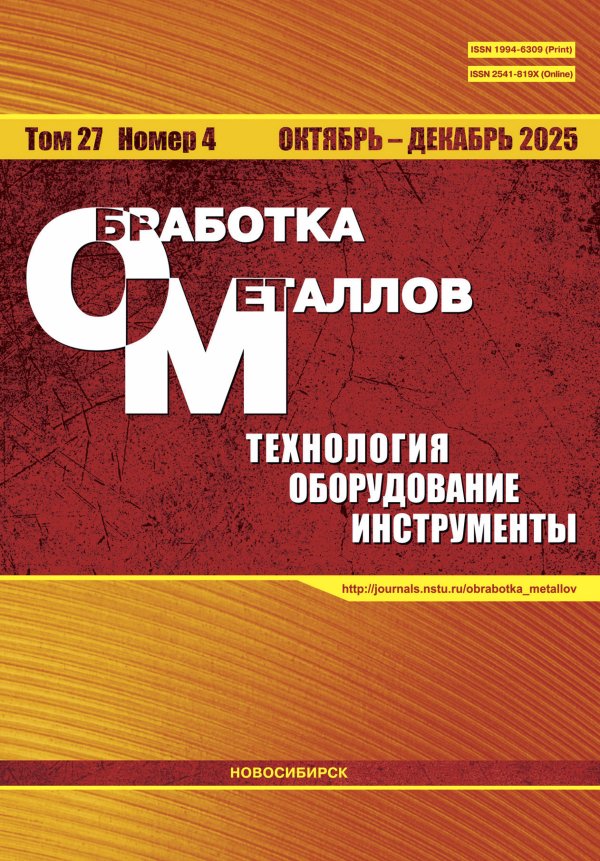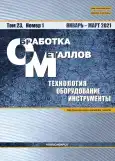Исследование обрабатываемости фрезерованием композита Inconel 625 с добавлением NiTi-TiВ2, полученного лазерным спеканием
- Авторы: Арляпов А.Ю.1, Волков С.Ю.1, Промахов В.В.1, Жуков А.С.1
-
Учреждения:
- Выпуск: Том 23, № 1 (2021)
- Страницы: 21-32
- Раздел: ТЕХНОЛОГИЯ
- URL: https://medbiosci.ru/1994-6309/article/view/301930
- DOI: https://doi.org/10.17212/1994-6309-2021-23.1-21-32
- ID: 301930
Цитировать
Аннотация
Ключевые слова
Об авторах
А. Ю. Арляпов
Email: arlyapov@tpu.ru
канд. техн. наук, Национальный исследовательский Томский политехнический университет, пр. Ленина, 30, г. Томск, 634050, Россия, arlyapov@tpu.ru
С. Ю. Волков
Email: vsu@pkmion.ru
Национальный исследовательский Томский политехнический университет, пр. Ленина, 30, г. Томск, 634050, Россия, vsu@pkmion.ru
В. В. Промахов
Email: vvpromkhov@mail.ru
канд. техн. наук, Национальный исследовательский Томский государственный университет, пр. Ленина, 36, г. Томск, 634050, Россия, vvpromkhov@mail.ru
А. С. Жуков
Email: zhuk_77@mail.ru
доктор физ.-мат. наук, Национальный исследовательский Томский государственный университет, пр. Ленина, 36, г. Томск, 634050, Россия, zhuk_77@mail.ru
Список литературы
- Inconel 625/TiB2 metal matrix composites by direct laser deposition / V. Promakhov, A. Zhukov, M. Ziatdinov, I. Zhukov, N. Schulz, S. Kovalchuk, Y. Dubkova, R. Korsmik, O. Klimova-Korsmik, G. Turichin, A. Perminov // Metals. – 2019. – Vol. 9, iss. 2. – P. 141. – doi: 10.3390/met9020141.
- Microhardness and microstructure evolution of TiB2 reinforced Inconel 625/TiB2 composite produced by selective laser melting / B. Zhang, G. Bi, S. Nai, C. Sun, J. Wei // Optics and Laser Technology. – 2016. – Vol. 80. – P. 186–195. – doi: 10.1016/j.optlastec.2016.01.010.
- Patel M.R.R., Ranjan M.A. Advanced techniques in machining of aerospace superalloys: a review // International Journal of Advance Research in Engineering, Science and Technology. – 2015. – Vol. 2, iss. 5. – P. 149–154. – doi: 10.26527/ijarest.150507103716.
- Баранчиков В.И., Тарапанов А.С., Харламов Г.А. Обработка специальных материалов в машиностроении: справочник. – М.: Машиностроение, 2002. – 264 с. – (Библиотека технолога). – ISBN 5-217-03132-8.
- Microstructure and mechanical properties of selective laser melted Inconel 718 compared to forging and casting / T. Trosch, J. Strößner, R. Völkl, U. Glatzel // Materials letters. – 2016. – Vol. 164. – P. 428–431. – doi: 10.1016/j.matlet.2015.10.136.
- Грановский Г.И., Грановский В.Г. Резание металлов: учебник для машиностроительных и приборостроительных специальностей вузов. – М.: Высшая школа, 1985. – 304 с.
- Cutting force and surface finish analysis of machining additive manufactured titanium alloy Ti-6Al-4V / A. Polishetty, M. Shunmugavel, M. Goldberg, G. Littlefair, R.K. Singh // Procedia Manufacturing. – 2017. – Vol. 7. – P. 284–289. – doi: 10.1016/j.promfg.2016.12.071.
- A brief review on machining of Inconel 718 / S. Roy, R. Kumar, Anurag, A. Panda, R.K. Das // Materials Today: Proceedings. – 2018. – Vol. 5, iss. 9. – P. 18664–18673. – doi: 10.1016/j.matpr.2018.06.212.
- Масленков С.Б. Жаропрочные стали и сплавы: справочник. – М.: Металлургия, 1983. – 192 с. – ISBN 978-5-458-28144-7.
- Arunachalam R., Mannan M.A. Machinability of nickel-based high temperature alloys // Machining Science and Technology. – 2000. – Vol. 4, iss. 1. – P. 127–168. – doi: 10.1080/10940340008945703.
- Технология обработки металлов резанием: учебное пособие. – Б. м.: Sandvik Coromant, 2009. – 359 с.
- Grguraš D., Kern M., Pušavec F. Suitability of the full body ceramic end milling tools for high speed machining of nickel based alloy Inconel 718 // Procedia CIRP. – 2018. – Vol. 77. – P. 630–633. – doi: 10.1016/j.procir.2018.08.190.
- Latest machining technologies of hard-to-cut materials by ultrasonic machine tool / F. Feucht, J. Ketelaer, A. Wolff, M. Mori, M. Fujishima // Procedia CIRP. – 2014. – Vol. 14. – P. 148–152. – doi: 10.1016/j.procir.2014.03.040.
- Kuo K.L., Tsao C.C. Rotary ultrasonic-assisted milling of brittle materials // Transactions of Nonferrous Metals Society of China. – 2012. – Vol. 22, suppl. 3. – P. 793–800. – doi: 10.1016/S1003-6326(12)61806-8.
- Influence of ultrasonic assistance on delamination during machining of different composite materials / M. Kuruc, M. Necpal, T. Vopát, V. Šimna, J. Peterka // Annals of DAAAM and Proceedings. – 2017. – Vol. 28. – doi: 10.2507/28th.daaam.proceedings.055.
- Ni C., Zhu L., Yang Z. Comparative investigation of tool wear mechanism and corresponding machined surface characterization in feed-direction ultrasonic vibration assisted milling of Ti–6Al–4V from dynamic view // Wear. – 2019. – Vol. 436–437. – P. 203006. – doi: 10.1016/j.wear.2019.203006.
- HEM Guidebook: a machinist’;s guide to increasing shop productivity with high efficiency milling. – Harvey Performance Company, LLC, 2017. – URL: https://www.harveyperformance.com/in-the-loupe/hem-guidebook-download/ (accessed: 15.01.2021).
- Roberts S. High-efficiency milling speed changes rules // Canadian Metalworking. – 2018. – January 10. – URL: https://www.canadianmetalworking.com/article/cuttingtools/high-efficiency-milling-speed-changes-rules (accessed: 15.01.2021).
- Derek K. Optimize cutting efficiency, optimize throughput // Modern Machine Shop. – 2005. – February 15. – URL: https://www.mmsonline.com/articles/optimize-cutting-efficiency-optimize-throughput (accessed: 15.01.2021).
- High Speed Machining Vs. HEM. – 2017. – August 11. – URL: https://www.harveyperformance.com/in-the-loupe/high-efficiency-milling-vs-high-speed-machining/ (accessed: 15.01.2021).
- High efficiency vs. High Feed Milling: which is more productive? // Modern Machine Shop. – 2018. – November 2. – URL: https://www.mmsonline.com/articles/high-efficiency-vs-high-feed-milling-which-is-more-productive (accessed: 15.01.2021).
- Каталог режущего инструмента компании «ПК МИОН». – Томск, 2019. – URL: http://pkmion.ru/catalog/frezy/ (дата обращения: 15.01.2021).
Дополнительные файлы







